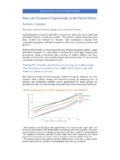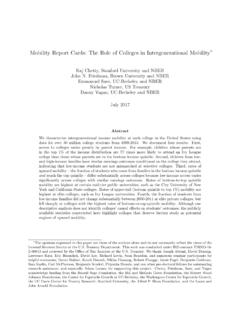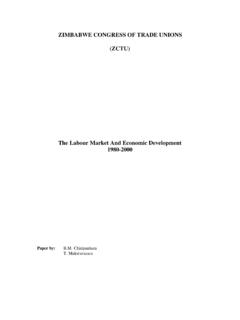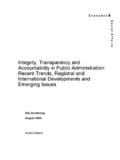Transcription of NBER WORKING PAPER SERIES THE FADING AMERICAN …
1 NBER WORKING PAPER SERIESTHE FADING AMERICAN DREAM: trends IN ABSOLUTE INCOME MOBILITY since 1940 Raj ChettyDavid GruskyMaximilian HellNathaniel HendrenRobert ManducaJimmy NarangWorking PAPER 22910 BUREAU OF ECONOMIC RESEARCH1050 Massachusetts AvenueCambridge, MA 02138 December 2016We thank Rebecca Diamond, Guido Imbens, Xavier Jaravel, Sean Reardon, and numerous seminar participants for helpful comments, Robert Fluegge and our other pre-doctoral fellows for outstanding research assistance, and David Leonhardt for posing the question that led to this research. This PAPER incorporates results from an independent WORKING PAPER by Robert Manduca entitled Opportunity No More: Declining Absolute Mobility in the United States, 1940-2010. This research was funded by Stanford University, Harvard University, the Bill and Melinda Gates Foundation, and the Robert Wood Johnson Foundation.
2 The views expressed herein are those of the authors and do not necessarily reflect the views of the National Bureau of Economic WORKING papers are circulated for discussion and comment purposes. They have not been peer-reviewed or been subject to the review by the NBER Board of Directors that accompanies official NBER publications. 2016 by Raj Chetty, David Grusky, Maximilian Hell, Nathaniel Hendren, Robert Manduca, and Jimmy Narang. All rights reserved. Short sections of text, not to exceed two paragraphs, may be quoted without explicit permission provided that full credit, including notice, is given to the FADING AMERICAN Dream: trends in Absolute Income Mobility since 1940 Raj Chetty, David Grusky, Maximilian Hell, Nathaniel Hendren, Robert Manduca, and JimmyNarangNBER WORKING PAPER No. 22910 December 2016 JEL No.
3 H0,J0 ABSTRACTWe estimate rates of absolute income mobility the fraction of children who earn more than their parents by combining historical data from Census and CPS cross-sections with panel data for recent birth cohorts from de-identified tax records. Our approach overcomes the key data limitation that has hampered research on trends in intergenerational mobility: the lack of large panel datasets linking parents and children. We find that rates of absolute mobility have fallen from approximately 90%for children born in 1940 to 50% for children born in the 1980s. The result that absolute mobility has fallen sharply over the past half century is robust to the choice of price deflator, the definition of income, and accounting for taxes and transfers. In counterfactual simulations, we find that increasing GDP growth rates alone cannot restore absolute mobility to the rates experienced by children born in the 1940s.
4 In contrast, changing the distribution of growth across income groups to the more equal distribution experienced by the 1940 birth cohort would reverse more than 70% of the decline in mobility. These results imply that reviving the AMERICAN Dream of high rates of absolute mobility would require economic growth that is spread more broadly across the income ChettyDepartment of EconomicsStanford University579 Serra MallStanford, CA 94305and GruskyStanford Center on Poverty & InequalityStanford University450 Serra Mall, Building 80 Stanford, CA HellStanford Center on Poverty & InequalityStanford University450 Serra Mall, Building 80 Stanford, CA HendrenHarvard UniversityDepartment of EconomicsLittauer Center Room 235 Cambridge, MA 02138and ManducaHarvard University79 JFK StreetCambridge, MA NarangUC-Berkeley, Dept.
5 Of Economics579 Evans HallBerkeley, CA One of the defining features of the AMERICAN Dream is the ideal that children have a higher standard of living than their parents (Samuel 2012). When children are asked to assess their economic progress, they frequently compare their own standard of living to that of their parents (Goldthorpe 1987, Hoschschild 2016). Such measures of absolute income mobility the fraction of children earning or consuming more than their parents are also often the focus of policy makers when judging the degree of economic opportunity in the ( , Obama 2013).1 In this PAPER , we assess whether the is living up to this ideal by studying two questions. First, what fraction of children earn more than their parents today? Second, how have rates of absolute mobility changed over time?
6 Despite longstanding interest in these questions, evidence on absolute income mobility remains scarce (Halikias and Reeves 2016), largely because of the lack of large, high-quality panel datasets linking children to their parents in the We overcome this data problem by developing a new method of estimating rates of absolute mobility that can be implemented using existing datasets covering the 1940-84 birth cohorts. Our approach combines two inputs: marginal income distributions for parents and children and the copula of the parent and child income distribution, defined as the joint distribution of parent and child income ranks. We estimate marginal income distributions for parents and children of the 1940-1984 birth cohorts using cross-sectional data from the decennial Census and Current Population Surveys (CPS).
7 In our baseline analysis, we measure income in pre-tax dollars at the household level when parents and children are approximately thirty years old, adjusting for inflation using the CPI-U-RS. We then show the robustness of our results to a variety of specification choices, such as using alternative inflation adjustments, adjusting for taxes and transfers, and measuring income at later ages. We estimate the fraction of children who earn more than their parents in each birth cohort by combining the marginal income distributions with the copula in each cohort. For recent birth cohorts, we follow Chetty et al. (2014a) and directly estimate the joint distribution of parent and child ranks using information from de-identified federal income tax returns covering the population. For earlier birth cohorts, such population-level panel data are not available.
8 We instead proceed in two 1 In a 2013 speech on economic mobility, President Obama noted that people s frustrations are partly rooted in the fear that their kids won t be better off than they were. 2 Prior research has studied the level of absolute income mobility for recent cohorts in the using panel surveys such as the Panel Study of Income Dynamics ( , Isaacs, Sawhill, and Haskins 2008, Lopoo and DeLeire 2012; Bengali and Daly 2013; Acs, Elliott, and Kalish 2016). These studies yield conflicting results because estimates of absolute mobility using available panel income datasets are sensitive to econometric assumptions and sample specification (Halikias and Reeves 2016). To the best of our knowledge, there is no evidence on trends in absolute income mobility, although prior studies have documented declining absolute mobility in terms of occupational status (Hauser et al.)
9 2000) and educational attainment (Hout and Janus 2011). 2 steps. First, we report estimates of absolute mobility under the assumption that the copula remained stable across all birth cohorts, a benchmark motivated by evidence of copula stability since the 1970s (Chetty et al. 2014b).3 Because we have no evidence that the copula was in fact stable prior to 1970, we then construct upper and lower bounds on absolute mobility for each birth cohort by searching over all plausible copulas using linear programming The key technical result of the PAPER is that these bounds are very tight for the 1940-1950 birth cohorts, allowing us to obtain a reliable time SERIES on rates of absolute mobility despite the lack of historical panel data. Using this methodology, we find that rates of absolute upward income mobility in the United States have fallen sharply since 1940.
10 Under the benchmark of copula stability, the fraction of children earning more than their parents fell from 92% in the 1940 birth cohort to 50% in the 1984 birth cohort. Rates of absolute mobility fell the most for children with parents in the middle class. Relaxing the copula stability assumption for earlier cohorts, we find that the rate of absolute mobility for the 1940 birth cohort is bounded between 84% and 98% across all plausible copulas, well above the rates observed for recent cohorts. Absolute mobility is not very sensitive to the copula for the 1940 birth cohort because income grew very rapidly at all quantiles of the distribution between 1940 and 1970. As a result, nearly all children earned more than the highest-income earners in their parents generation, implying rates of absolute mobility near 100% regardless of which children were linked to which parents.








